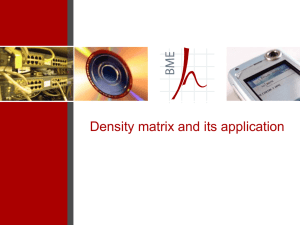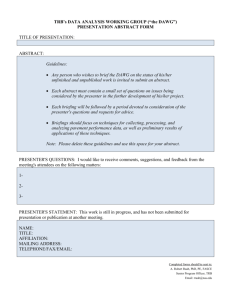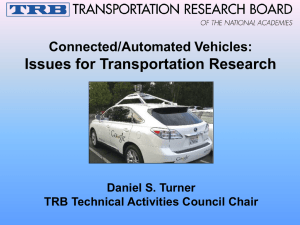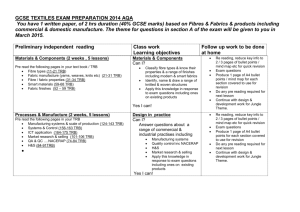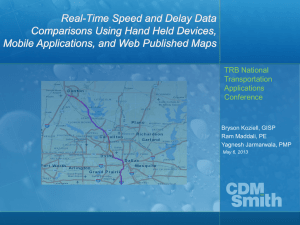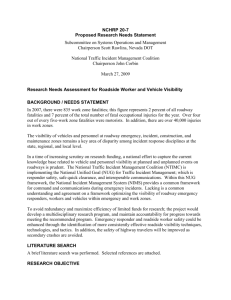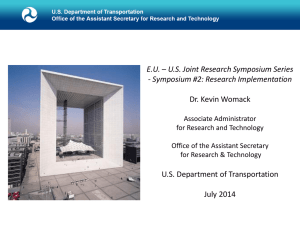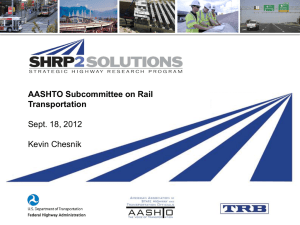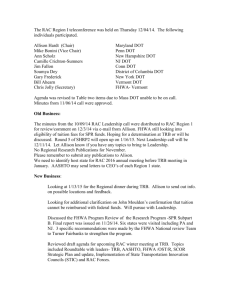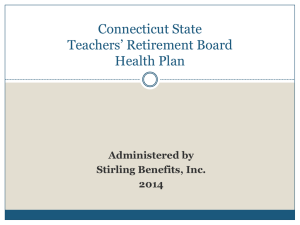Self Evaluation of TRB Committees(3rd draft)
advertisement
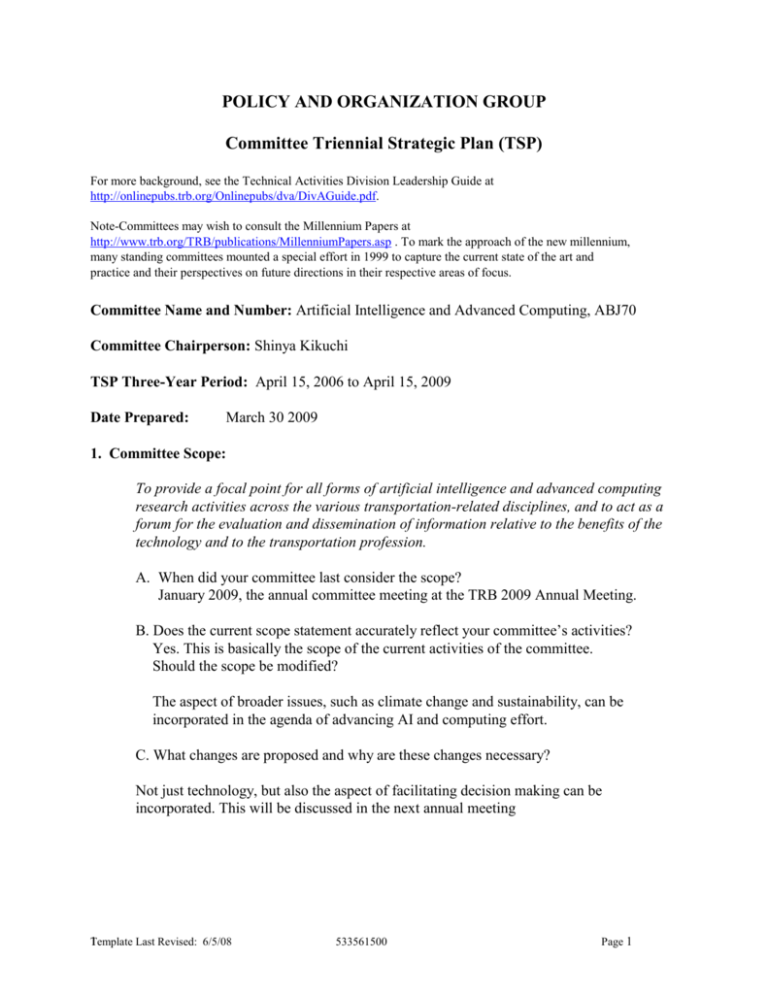
POLICY AND ORGANIZATION GROUP Committee Triennial Strategic Plan (TSP) For more background, see the Technical Activities Division Leadership Guide at http://onlinepubs.trb.org/Onlinepubs/dva/DivAGuide.pdf. Note-Committees may wish to consult the Millennium Papers at http://www.trb.org/TRB/publications/MillenniumPapers.asp . To mark the approach of the new millennium, many standing committees mounted a special effort in 1999 to capture the current state of the art and practice and their perspectives on future directions in their respective areas of focus. Committee Name and Number: Artificial Intelligence and Advanced Computing, ABJ70 Committee Chairperson: Shinya Kikuchi TSP Three-Year Period: April 15, 2006 to April 15, 2009 Date Prepared: March 30 2009 1. Committee Scope: To provide a focal point for all forms of artificial intelligence and advanced computing research activities across the various transportation-related disciplines, and to act as a forum for the evaluation and dissemination of information relative to the benefits of the technology and to the transportation profession. A. When did your committee last consider the scope? January 2009, the annual committee meeting at the TRB 2009 Annual Meeting. B. Does the current scope statement accurately reflect your committee’s activities? Yes. This is basically the scope of the current activities of the committee. Should the scope be modified? The aspect of broader issues, such as climate change and sustainability, can be incorporated in the agenda of advancing AI and computing effort. C. What changes are proposed and why are these changes necessary? Not just technology, but also the aspect of facilitating decision making can be incorporated. This will be discussed in the next annual meeting Template Last Revised: 6/5/08 1 533561500 Page 1 2. Committee Strategic Planning A. Has your committee conducted strategic planning sessions? If so, please attach results. We have the following Mission and strategic focuses. Mission To serve as a technical forum on Artificial Intelligence (AI) and advanced computing solutions for the promotion of research on and their application to transportation problems, for the evaluation of their theoretical and practical merits, and for the dissemination of those solutions that are deemed credible and potentially useful to the transportation community. Strategic Focus Areas The committee focuses on the following areas Identify emerging AI and computation knowledge and methods Develop schemes for application of AI methods Identify application areas for AI innovations Identify implementation issues Identifying knowledge gaps in the transportation community Search for future AI and computing directions Establish and expand links with other TRB committees Develop more AI "success stories" Outcomes Publish a list of AI research needs in TRB Circulars every 2-3 years. Sponsor sessions on applications, emerging tools, evaluation of tools and education (at least 2 paper sessions per year and 1 conference session) Work with domain committees to offer joint posters and sessions Participate in the TRB Mid-year meeting in 2009 B. If you have not done strategic planning, what are your committee’s strategic directions for the future? We have not organized a “strategic” planning meeting per se; however, we have discussed our strategies, focus areas, and outcomes as listed above. Our focus remains in promotion of research, application, evaluation and dissemination of findings. Our strategic direction is to relate to AI and computing tools to the real world and to offer specific help to other TRB committees and the general transportation community in terms of the concept of AI and specific application approach. An area of special interest is in data: dealing with missing data, data accuracy consistency, precision vs. accuracy, and data management, and knowledge building using data (transformation of data to information). For that reason we have Template Last Revised: 6/5/08 2 533561500 Page 2 decided to increase our cooperative effort with other committees. A joint session at the 2009 TRB Mid-Year meeting is our first such attempt. 3. Critical and Cross-cutting Issues Identify committee’s activities that helped address any critical and cross-cutting issues identified by (a) the committee,(b) the TRB Executive Committee (http://onlinepubs.trb.org/Onlinepubs/general/CriticalIssues06.pdf) ,(c) the Technical Activities Council (http://onlinepubs.trb.org/Onlinepubs/dva/DivAGuide.pdf, p. 58), and (d) the Policy and Organization Group (http://www.trb.org/Committees/AB000/IssueDesc2006.pdf) that fall under the scope of the committee. A. What are the key long term and emerging issues that your committee is tracking? Data integrity issues: Data validation, Treatment of missing data Treatment of Uncertainty: non-traditional approach to uncertainty such as treatment of qualitative data, language based data, fuzzy inference and controls Knowledge: Knowledge extraction, model validation Identification of changes in transportation in the future, including Impacts of changes in fuel, e.g., ar with non-petro based fuel Development of walk-aids device. (Segway, Motorized bike, Motorized wheelchairs) Community sharing of mobility device (Car sharing, bike sharing,) Intermodal integration. Application and roles of robots in transportation C. What plans do you have to address cross-cutting issues with other committees? We are organizing a joint session with ABJ10 (National Transportation Database) at the 2009 Mid-Year TRB meeting. This is the first event that this committee ever meets at the mid-year meeting. Our committee is planning to present types of problem they have in terms of the data quality and interpretation; we then present the available approach using Artificial Intelligence and computation to improve the quality of data. In addition, this committee will have 2 session during the mid-year meeting. These sessions are specifically designed to interact with people outside the committee; we are planning 3 presentations by non-members; Argonne national lab and the City of Seatttle. The joint meeting with ABJ10 aims to issue a call-for-papers and to plan a joint session during the TRB 2011 meeting. 4. Committee Activity Plans A. What activities are planned next year to achieve your goals? Template Last Revised: 6/5/08 3 533561500 Page 3 Two webinar plans have been submitted to TRB. They are Advanced Methods for Model Selection and Validation Travel time prediction (information) methods and evaluation First Webinar. Most transportation models in use today have been developed on how well they fit the data on which they have been estimated. Most are not sufficiently validated, in the sense that they have not been truly tested on how well they predict new cases. The result is that models, especially highly complex models, tend to be overfitted to the data. The greater the overfitting of a model, the more its predictive capability is degraded. Current modeling practice in advanced fields such as bioinformatics is to select and test models addresses the problem of overfitting by using model performance measures that penalize overly complex models; these models are also tested for their predictive performance on completely new data. This webinar will provide a review of advanced model selection and validation procedures, introducing participants to methods that have been well-established in other fields. This webinar is intended primarily for practitioners and researchers working with complex models such as travel demand forecasting models and traffic microsimulation models. Second webinar. This webinar presents available approaches for predicting highway travel time, reviews their performances and limitations, and discusses the impacts of such information on the travel experience and travel behavior. This committee continues its tradition of organizing two Sunday Workshop sessions at the annual meeting in 2010. The themes for 2010 meeting have not been finalized yet, however, usually in the am workshop we focus on the real world application (for example in 2009, transit scheduling problem), and in the pm workshop we focus on the philosophical and general issues of AI and computation in transportation analysis. B. What activities are envisioned in future years? The committee has approved to work on publication of Circular on Artificial Intelligence and Advanced Computing in 2012. The committee published a Circular in 2006, and a new effort is going to be made to update the previous circular. . 5. Committee Organization and Membership A. Describe the membership gender and racial diversity. 2 women members 2 emeritus members 6 international members 2 industry professional members 2 African American members 9 Asian and Southwest Asian members Template Last Revised: 6/5/08 4 533561500 Page 4 B. How is membership distributed geographically? Eastern US 9 Western US 2 Central US 5 International 6 C. How is membership distributed across professional affiliation? State Government 0 Education 19 Local Government 1 Federal Government 0 Private Sector 2 Nonprofit/Other D. How many “friends” are associated with the committee? 20 E. List subcommittees and their chairs. Research Subcommittee, Chair, David Reinke Education – Outreach - Real World Connection Subcommittee, Co-chairs: Adel Sadek, Yunlong Zhang, and James Cooper Paper Review Subcommittee, Chair, Gary Spring 6. Interaction with Other TRB Committees, Organizations, and Customers A. List other TRB committees which your committee maintains a formal liaison representation. Our committee members are Members of eth following committee as well. ABE40--Critical Transportation Infrastructure Protection ABJ50-- Information Systems and Technology AFB10--Geometric Design Committee ADC20--Transportation and Air Quality Committee AH010--Surface Transportation Weather Committee ANB75T--Member of the TRB Roundabout Task Force ABC30--Performance Measurement Committee AHB25--Traffic Signal System committee AHB65--Operational Effects of Geometrics Committee AHB20--Freeway operations committee ABJ 80--Statistical Methodology and Statistical Computer Software in Transportation Research Committee ADB10--Traveler Behavior and Values Committee AND20--User Information Systems Committee ABC40--Transportation Asset Management. B. List outside organizations which your committee maintains ongoing liaison representation. Template Last Revised: 6/5/08 5 533561500 Page 5 C. List shared activities during the past year (examples should include work on crosscutting issues, information exchange, research, etc.) 7. Business Meeting Attendance (information from the most recent meeting) A. Annual business meeting: Members 20__ Guests 30__ B. Summer business meeting: Members 5 Guests 3 (anticipated for the 2009 Summer meeting) NA ___ 8. Technology Transfer Activities for Colleagues and Customers A. Is the committee planning to publish documents within the next two years? (proceedings, circulars, etc.) Please list and give anticipated dates. Circular on AI and advanced computing in Transportation in 2011. B. Workshops proposed (excluding the TRB Annual Meeting). If the proposed webinars are successful, then we probably organize a follow-on workshop. C. Conferences proposed. D. Other activities (web pages, newsletters, updating of millennium paper, etc.) 9. Research Needs and Problem Statements (Of particular interest are problem statements for TRB Cooperative Research Programs, but please list related activities your committee is involved with as well.) A. How do you determine and select research needs and problem statements? (workshops, call for ideas, etc.) They are identified at the annual committee meeting. The current research needs and activity orientation are Data integrity issues: Data validation, Treatment of missing data Treatment of Uncertainty: non-traditional approach to uncertainty such as treatment of qualitative data, language based data, fuzzy inference and controls Knowledge: Knowledge extraction, model validation Template Last Revised: 6/5/08 6 533561500 Page 6 Identification of changes in transportation in the future and definethe role of AI and computing, e.g., use of robots for transportation. B. Number of Research Problem Statements currently under development? 4 C. List Research Problem Statements funded during last three years? D. Are the statements available to the public (for example, in TRB Research Needs Database, http://rns.trb.org/)? 10. General Remarks and Comments Offered by the Committee A. Should your committee continue in its present form with its present title? No If no, please explain. The committee title was revised 2 years ago after long deliberation; thus, at the moment, no plan to change the title. B. Should it be merged with one or more other committees? No If yes, please explain. D. Any other comments considered appropriate by the committee. As the domain of the analysis of transportation expands and the fact that many issues are interrelated in a complex manner, transportation professionals are facing a new set of challenges. They include how to solve the multi-objective and multi-constraint problems to the best satisfaction of the individual stakeholders; how to deal with the incomplete and inconsistent data; how to formalize the incomplete knowledge and create a useful set of models; and how to reason and make decision under such circumstances. The nature of transportation problems has been predominantly prediction. However, diagnosis, abduction, and control and regulation will become important part of the analysis. For these new situations, we need to expand the scope of the traditional analytical paradigms. Artificial Intelligence and advanced computation techniques is a set of analytical tools which deal with complex problems involving the heuristic knowledge, different forms of information (e.g., language), rule-based inference and control, trialand-error solution, as well as creating knowledge from the available data. Tools developed under AI and computation should be exploited in order to solve the complex problems. Therefore, it is natural that TRB has a committee that unites the experts in the field of AI and computation so that they monitor the developments in the AI field, to interpret the effectiveness of the tools for possible application in transportation, to demonstrate the benefits, and to help apply them to solve the real world problems. We feel that the role of this committee in TRB becomes very important in the future. Template Last Revised: 6/5/08 7 533561500 Page 7 The members and the friends of ABJ70 are committed to advance AI and computational tools in transportation application. The majority of the members are in academia; this is rather natural given that the nature of the work is in the development of knowledge. However, the usefulness of the committee in TRB lies in its ability to interact with other committees and help solve the real world problems. In this respect, this committee has not been as effective as it can be. Thus, the critical area that the committee should concentrate is in the interaction with other committees and also application of tools to the real world problems. In this respect, we are pleased that for the first time we are organizing sessions in the mid year meeting and also a joint session with ABJ10, national Transportation Database. The effort to develop webinars will also enhance our capability to interact with the application community. This committee continues to organize two Sunday Workshop sessions (am and pm), which have been our flagship activities, as well as two presentation sessions and one poster session. 11. Annual Reports of Committee Activities (Please attach last three years of annual reports and supporting documents). Template Last Revised: 6/5/08 8 533561500 Page 8
